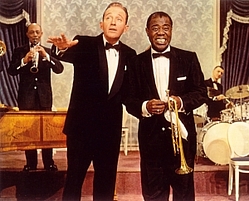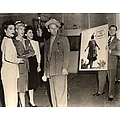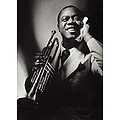Bing Crosby & Louis Armstrong Biography
Harry Lillis “Bing” Crosby (May 2, 1903 - October 14, 1977) was an American singer and actor whose career lasted from 1926 until his death in 1977. Bing Crosby’s influence on popular culture and popular music is considerable, as from 1934 to 1954 he held a nearly unrivaled command of record sales, radio ratings and motion picture grosses. He is usually considered to be a member of popular music’s “holy trinity” of ultra-icons, alongside Elvis Presley and The Beatles. Bing Crosby popularized singing with conversational ease, or ‘crooning’. His musical interpretations amalgamated rhythm and romance with scat singing, whistling, rhythmic improvisation and melodic paraphrasing as elements of a hotter, sexier sound than had been conceived before. Crosby is also credited as being the major inspiration for most of the male singers that followed him, including the likes of Frank Sinatra, Perry Como and Dean Martin. Tony Bennett summed up Crosby’s impact, stating, “Bing created a culture. He contributed more to popular music than any other person - he moulded popular music. Every singer in the business has taken something from Crosby. Every male singer has a Bing Crosby idiosyncracy.” Crosby’s recording of PlayWhite Christmas is recognized as the best-selling single in any music category with over 40 million copies sold. In 1962, Crosby was the first person to receive the Grammy Lifetime Achievement Award. Louis Armstrong (1901-1971) was a trumpet player, singer, bandleader, and is widely regarded as one of the most influential artists in the history of jazz. Armstrong was born and raised in New Orleans, a culturally diverse town with a unique musical mix of creole, ragtime, marching bands and blues. Although from an early age he was able to play music professionally, he never traveled far from New Orleans until 1922, when he went to Chicago to join his mentor, King Oliver. Oliver’s band played primitive jazz, a hotter style of ragtime, with looser rhythm and more improvisation, and Armstrong’s role was mostly backup. Slow to promote himself, he was eventually persuaded by his wife to leave Oliver, and In 1924 he went to New York to join the Fletcher Henderson Orchestra. At the time, there were a few other artists using the rhythmic innovations of the New Orleans style, but none did it with the energy and brilliance of Armstrong, and he quickly became a sensation among New York musicians. Back in Chicago in 1925, he made his first recordings with his own group, Louis Armstrong and his Hot Five, and these became not only popular hits but also models for the first generation of jazz musicians, trumpeter or otherwise. Other hits followed through the twenties and thirties, as well as troubles: crooked managers, lip injuries, mob entanglements, failed big-band ventures. As jazz styles changed though, musical purists never lost any respect for him —although they were sometimes irritated by his hammy onstage persona. Around the late forties, with the help of a good manager, Armstrong’s business affairs finally stablilized and he began to be seen as an elder statesman of American popular entertainment, appearing in Hollywood movies, touring Asia and Europe, and dislodging The Beatles from the #1 position with “Hello, Dolly”. Today more people may know him as a singer (a good one), but as Miles Davis said: “You can’t play nothing on modern trumpet that doesn’t come from him.”
Bing Crosby & Louis Armstrong Lyrics
Write a comment
What do you think about Bing Crosby & Louis Armstrong? Let us know in the comments below!
Bing Crosby & Louis Armstrong Albums
| Title | Release | ||
|---|---|---|---|
| 1 | Bing's Best | ||
| 2 | Bewitched |

















